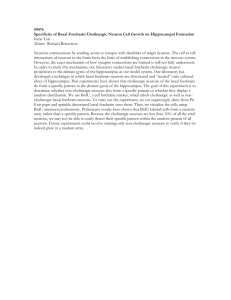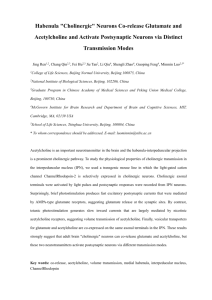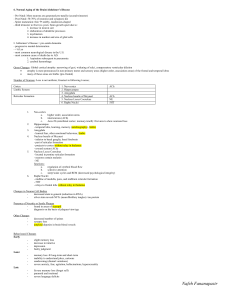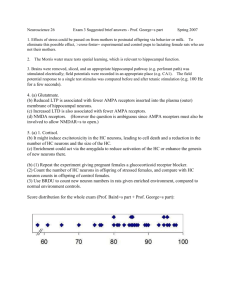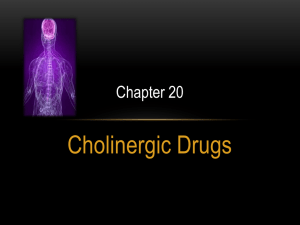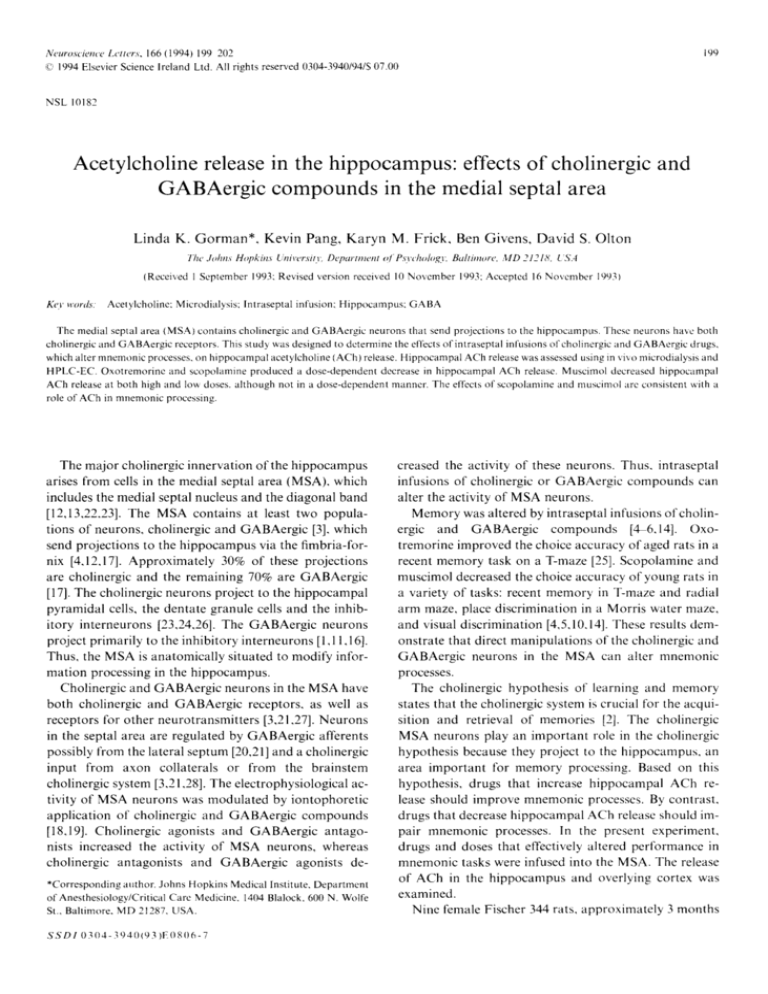
Neurosciem'e Lctlers, 166 (1994} 199 202
© 1994 Elsevier Science Ireland Ltd. All rights reserved 0304-3940/94/S 07.00
199
NSL 10182
Acetylcholine release in the hippocampus: effects of cholinergic and
GABAergic compounds in the medial septal area
Linda K. Gorman*, Kevin Pang, Karyn M. Frick, Ben Givens, David S. Olton
771e Johns Hopk in.~ University, Department ol' Psycho/ogy, Baltimore, M D 21218, I~S,4
(Received 1 September 1993: Revised version received 10 November 1993: Accepted 16 November 1993)
Key words.
Acelylcholine: Microdialysis; Intraseptal infusion: Hippocampus: GABA
The medial septal area (MSA) contains cholinergic and GABAergic neurons that send projections to the hippocampus. These neurons have both
cholinergic and GABAergic receptors. This study was designed to determine the effects ofintraseptal infusions of cholinergic and GABAergic drugs,
which alter mnemonic processes, oil hippocampal acetylcholine (ACh) release. Hippocampal ACh release was assessed using in vivo microdialysis and
HPLC-EC. Oxotremorine and scopolamine produced a dose-dependent decrease in hippocampal ACh release. Muscimol decreased hippocampal
ACh release at both high and low doses, although not in a dose-dependent manner. The effects of scopolamine and muscimol are consistent with a
role of ACh in mnemonic processing.
The major cholinergic innervation of the hippocampus
arises from cells in the medial septal area (MSA), which
includes the medial septal nucleus and the diagonal band
[12,13,22,23]. The MSA contains at least two populations of neurons, cholinergic and GABAergic [3], which
send projections to the hippocampus via the fimbria-fornix [4,12,17]. Approximately 30% of these projections
are cholinergic and the remaining 70% are GABAergic
[17]. The cholinergic neurons project to the hippocampal
pyramidal cells, the dentate granule cells and the inhibitory interneurons [23,24,26]. The GABAergic neurons
project primarily to the inhibitory interneurons [1,11,16].
Thus, the MSA is anatomically situated to modify information processing in the hippocampus.
Cholinergic and GABAergic neurons in the MSA have
both cholinergic and GABAergic receptors, as well as
receptors for other neurotransmitters [3,21,27]. Neurons
in the septal area are regulated by GABAergic afferents
possibly from the lateral septum [20,21] and a cholinergic
input from axon collaterals or from the brainstem
cholinergic system [3,21,28]. The electrophysiological activity of MSA neurons was modulated by iontophoretic
application of cholinergic and GABAergic compounds
[18,19]. Cholinergic agonists and GABAergic antagonists increased the activity of MSA neurons, whereas
cholinergic antagonists and GABAergic agonists de*Correspondingauthor. Johns Hopkins Medical Institute, Department
of Anesthesiology/Critical Care Medicine. 1404 Blalock, 600 N. Wolfe
St., Baltimore, MD 21287, USA.
SSD1 0304-3940(93)E0806-7
creased the activity of these neurons. Thus, intraseptal
infusions of cholinergic or GABAergic compounds can
alter the activity of MSA neurons.
Memory was altered by intraseptal infusions ofcholinergic and GABAergic compounds [4 6,14]. Oxotremorine improved the choice accuracy of aged rats in a
recent memory task on a T-maze [25]. Scopolamine and
muscimol decreased the choice accuracy of young rats in
a variety of tasks: recent memory in T-maze and radial
arm maze, place discrimination in a Morris water maze,
and visual discrimination [4,5,10,14]. These results demonstrate that direct manipulations of the cholinergic and
GABAergic neurons in the MSA can alter mnemonic
processes.
The cholinergic hypothesis of learning and memory
states that the cholinergic system is crucial for the acquisition and retrieval of memories [2]. The cholinergic
MSA neurons play an important role in the cholinergic
hypothesis because they project to the hippocampus, an
area important for memory processing. Based on this
hypothesis, drugs that increase hippocampal ACh release should improve mnemonic processes. By contrast,
drugs that decrease hippocampal ACh release should impair mnemonic processes. In the present experiment,
drugs and doses that effectively altered performance in
mnemonic tasks were infused into the MSA. The release
of ACh in the hippocampus and overlying cortex was
examined.
Nine female Fischer 344 rats, approximately 3 months
200
of age, were anesthetized with a mixture of 33% 02, 66%
N202 and 1 2% ethrane (Anaquest) and implanted with
a microdialysis and drug infusion guide cannulae. The
microdialysis guide cannula was placed above the dura,
4.0 mm posterior and 2.5 mm lateral to bregma. The
guide cannula for drug infusion was placed 0.7 mm anterior and 1.5 mm lateral to bregma and 4.6 mm ventral to
dura, at a 15° angle with the tip toward the midline. The
guide cannula for drug infusion was a 10 mm long, 26
gauge stainless steel tubing. Both cannulae were fixed to
the skull with dental acrylic (Bioanalytical Systems).
Experiments were carried out 24 h after cannulae implantation. A microdialysis probe (Bioanalytical System,
CMA/10 dialyzing length = 3 ram) was placed in the hippocampus and overlying cortex and continuously perfused with physiological Ringer's solution (147 mM
NaCI, 4 mM KC1, 2.3 mM CaC1) containing 100/,tM
neostigmine bromide, an acetylcholinesterase inhibitor.
Microdialysate samples were collected by perfusing the
Ringer's solution into the brain at a rate of 5/.d/rain.
Each sample period was 5 rain. Six or seven baseline
dialysate samples were collected prior to drug infusion
and twelve samples were collected after drug infusion.
During the entire session, the rat was able to move freely
in a testing chamber (22 cm x 23 cm x 21 cm) constructed
of clear Plexiglas.
Each rat was randomly assigned to one of the 3 drug
groups: (1) scopolamine (SCOP, t5 and 30 ~g), (2) oxotremorine, (OXO, 0.5 and 2 /.tg), and (3) muscimol
(MUS, 15 and 30 ng). Each group had 3 rats. Each rat
received a total of 3 infusions of one drug in the following order: high dose of the drug, low dose of the drug and
saline. All compounds were obtained from Sigma Chemical (St. Louis, MO, USA) and were dissolved in 0.9%
sterile saline solution. The drug injector (12 mm long, 26
gauge stainless steel tube) was inserted into the guide
cannula, extending 2 mm from the tip of the guide cannula. Each drug was delivered (Sage Instruments syringe
pump, Model 341B) at a rate of 0.1 /.tl/min for 5 rain.
During the drug infusion, the rat was free to move about
the chamber. The injector was left in place for an additional minute and then removed. Three days were allowed between microinfusions.
Following the infusion experiments, a lethal dose of
choral hydrate was given and the rats were transcardially
perfused with a 10% formalin solution. The brain was
removed and cut into 50/.tm coronal sections. Sections
containing the tracks from the drug infusion and microdialysis probe were mounted and Nissl stained using
Neutral red. This histopathological evaluation was done
to verify anatomically the placement of the microdialysis
probe and drug infusion cannula, and to examine cells in
the vicinity of the infusion for gliosis. The microdialy-
z~
75
iI
[[llll
/I
Illtlqf'
J
Fig. 1. Scopolamine(30/.tg)decreasedhippocampal ACh levelsas compared to saline. The amount of ACh in each 5 rain microdialysatesample collectedfrom the same rat in two separate sessions are illustrated.
Values are calculated using an external standard. BASE equals the
average ACh levelprior to infusion.
sates were analyzed for their ACh content using H P L C
with electrochemical detection [7,8,15]. The detection
limit of the ACh assay was 2.5 fmol.
For each session, baseline release was determined
using the mean ACh level of the 4-5 samples immediately prior to infusion. Amounts of ACh in each of the
twelve dialysate samples collected during and after drug
infusion were expressed relative to baseline. The mean
change for each 5 min sample was calculated across all
rats in the same drug condition; Multiple planned comparisons were made between saline and low dose infusions and between saline and high dose infusions within
each drug group. The overall session mean was also computed using all 12 sample means. A negative value indicated a decrease of ACh release from baseline and a
positive value indicated an mcrease of ACh release from
baseline.
Histological evaluation of the tissue revealed correct
placement of the drug infusion cannula and microdialysis probe in all of the rats for which data is reported. A
glial reaction was noted around the injection site in the
MSA and in the area of the microdialysis probe in the
hippocampus. A lesion approximately the diameter of
the probe and drug injector was also noted.
lntraseptal infusions of saline altered hippocampal
ACh release in the hippocampus in 5 of the 9 rats. The
saline and SCOP (30/,/g) sessions for one rat are depicted
in Fig. 1. The overall mean percentage change of ACh
release following saline was 22%, 23%, and 9% for
SCOP, OXO, and MUS, respectively (Fig. 2b).
Both scopolamine, a cholinergic antagonist, and oxotremorine, a cholinerglc agonist, decreased hippocampal
ACh in a dose-dependent manner (Fig. 2). The low dose
of SCOP (15/lg) and OXO (0.5 pg) did not produce el'-
201
SCOI)OI.\MIN£ (ta,g )
~,
o
e5
i~ I
'
7
.... Ii
Ti
£g
~
5O i
100
+T
:
[O0
i
0
10
20
30
~0
OXOTREMORINE
50
5D
Na('[
t:5
i(I
(tx£)
5O
5{:
]
25=
]
£5
/'~
7
I
50
'
: O0
.
0
10
2°
.
. .
3O
,o
i,:)g
40
50
fJO
N,;I
:15
"vIUSC1MOL ( n g )
5O
E5
r
e5
F
-'-
•
--
~:
5O
70
I
100
0
\
|
T
10
~o
/0
~o
Time (rain)
~,0
,~:
~)0 ~i,iI. . . . . . .
]~
Fig. 2, lntraseptal infusions of SCOP, OXO, and MUS decreased hippocampal ACh release. Drug effects are expressed as the mean percentage change from baseline. Time response curves for the high dose of
each compound are illustrated in Fig. 2a. Each point represents the
mean value of samples from all rats in the drug group _+ S.E.M. The
overall session mean for each of the drug conditions (saline. low and
high dose) is shown in Fig. 2b. *P < 0.001. compared to saline.
fects that were significantly different from saline. The
high dose of SCOP (30 #g) and O X O (2/,/g) decreased
hippocampal ACh levels as compared to the saline control (Fk: 2 = 10.449, P = 0.004:F~.22 = 20.743, P = 0.000,
respectively). Both doses of muscimol, 15 and 30 ng, significantly decreased ACh levels as compared to saline
(FI.= = 11.594, P = 0.003:Fin2 = 8.595, P = 0.008, respectively).
The effects of scopolamine and muscimol on ACh release are consistent with the action of these compounds
on the cholinergic neurons in the MSA and impairments
in memory. Cholinergic antagonists and GABAergic agonists decrease the activity of MSA cholinergic neurons
[18,19]. Working m e m o r y was impaired following intraseptal infusions of scopolamine and muscimol [5,14].
In the present study, intraseptal infusion of SCOP ( 15 or
30#g) and MUS (15 or 30 ng) decreased ACh release in
the hippocampus. Thus, these results are consistent with
the idea that drugs that decrease the activity of MSA
neurons also decrease hippocampal ACh release and impair memory.
Oxotremorine decreased ACh release in a dose-de-
pendent manner. O X O (2 #g) decreased ACh release
below that of the saline controls, whereas O X O (0.5 #g)
had little effect. Both doses of oxotremorine improved
m e m o r y of aged rats in a T-maze alternation tasks
(Markowska et al., 1991 ). If drugs that improve memory
do so by increasing ACh release, then oxotremorine
should have increased ACh release in the hippocampus
following both doses. One possible explanation for this
inconsistency is the age of the rat. The present study was
performed in young animals and the behavioral data was
obtained in aged animals, lntraseptal infusion of carbachol, another cholinergic agonist, increased ACh in
young rats [9], but has not been shown to improve behavior in young rats (Givens, unpublished observation).
Combined data from microinI\tsions and microdialysis can provide information regarding the interaction between the cholinergic and GABAergic neurons of the
septohippocampal system. This information may help to
elucidate the neural mechanisms by which the MSA can
modulate behavioral performance. By providing neuroanatomical specificity, intracranial microinfusions are
a powerful way to pharmacologically manipulate small
populations of neurons. The results of the present study
are consistent with a number of predictions of cholinergic function based on electrophysiological and behavioral studies. Given the complexity of the septohippocampal system, additional studies are necessary to
determine the precise nature of the interactions between
the cholinergic and GABAergic systems.
The authors would like to thank Michelle Conroy,
Amy Moore. Mark Baxter, Spencer White and Wendy
Clark i\)r their technical assistance.
1 Babb, T . L . , Pretorius, J.K., Kupfer, W.R. and B r o w n , W,J., Distribution of glutamate decarboxylase inlmunorcactive neurons and
synapses in the rat and monke} hippocampus: light and electron
microscopy, J. Comp. Neurol., 27811988) 121 138.
2 Bartus. R.T., Dean, R.L, Beer, B. and Lippa. A.S.. The cholinergic
hypothesis of geriatric memory dysfunction. Science. 217 (19821
408 417.
3 Bialowas. J. and Frotscher, M.. Choline acetyltransferase-immunoreactivity neurons and terminals in the rat septal complex: a
combined light and electron microscopic study, J. Comp. Neurol.,
259 (198% 298 307.
4 Brioni, J.D., Decker, M.W_ Gamboa, L,P., Izquierdo, I. and
McGaugh. J.L_ Muscimol injections in the medial scptum impair
spatial learning, Brain Res., 522 (1990) 227 234.
5 Chrobak. J.J., Stackmam R.R. and Walsh. T.J.. lntraseptal administration of muscimol produces dose-dependent memory impairments in the rat, Behav. Neural Biol.. 52 (1989j 357 369.
6 Chrobak, J.J. and Napier, T.C., Intraseptal administration of bicucullme produces working memory impairments in the rat, Behav.
Neural Biol.. 55 (1991) 247 254.
7 Damsma, O., Westerink, B.H.C.. De Vries, J.B.. Van den Berg. ('.J.
and Horm A.S., Measurement of acetylcholine release in freely
2~2
8
9
10
11
12
13
14
15
16
17
moving rats by means of automated intracerebral dialysis. J. Neurochem., 48(1987) 1523 1528.
Damsma, G., Westerink, B.H.C., lmperato, A., Rollema. H.. De
Vries, J.B. and Horn, A.S., Automated brain dialysis of acetylcholine in freely moving rats: detection of basal acetylcholine.
Life Sci., 41 (19871 873 876.
De Boer, E, Moor, E., Zaagsma, J. and Westerink, B.H.C.. Consequences of septal manipulation on the release of acetylcholine from
the ventral hippocampus: an in vivo microdialysis study. In H. Rolleana, B.H.C. Westerink and W. Brigfhout (Eds.), Proceedings of
the 5th Int. Conference on In Vivo Methods, 1991, pp. 279 282.
Dudchenko, E and Sarter, M., GABAergic control of basal forebrain cholinergic neurons and memory, Behav. Brain Res., 42
(19911 33 41.
Freund, T.F. and Antal, M., GABA-containing neurons in the septum control inhibitory interneurons in the hippocampus, Nature,
336(19881 170 172.
Frotscher, M. and Leranth, C., Cholinergic innervation of the rat
hippocampus as revealed by choline acetyltransferase immunocytochemistry: a combined light and electron microscopic study, J.
Comp. Neurol., 239 (1985) 237 246.
Gaykema, R.P.A., Luiten, EG.M., Nyakas, C. and Traber, J., Cortical projection patterns of the medial septum-diagonal band complex, J. Comp. Neurol., 293 (1990) 103 124.
Givens, B.S. and Olton, D.S., Cholinergic and GABAergic modulation of medial septal area: effect on working memory, Behav. Neurosci., 104 (1990) 849 855.
Gorman, L.K. and Becker, D.P., Choline and acetylcholine analysis
in brain research, Chrompack International, Middelburg, The
Netherlands, Application Note 503541. 1990.
Gulyas, A.I., Seress, L., Toth, K., Acsady, L., Antal, M. and
Freund, T.F., Septal GABAergic neurons innervate inhibitory interneurons in the hippocampus of the macaque monkey, Neuroscience, 41 ( 1991 ) 381-390.
Kohler, C., Chan-Palay, V. and Wu, J.-Y., Septal neurons containing glutamic acid decarboxylase immunoreactivity project to the
hippocampal region in the rat brain, Anat. Embryol., 169 (1984)
41 44.
18 Lamour. Y., Dutar, E and Jobert, A.. Septohippocampal and other
medial septat-diagonal band neurons: electrophysiological ~lnd
pharmacological properties, Brain Res., 309 (1984} 227 239.
19 Lee, B.H., Lamour, Y. and Bassant, M.H., lontophoretic study of
medial septal neurons in the unanesthetized rat, Neurosci. l,ett,, 12,k
(1991129 32.
2(11 Leranth, (., Deller, T. and Buzsaki, G.. Intraz,eptal connections
redefined: lack of a lateral septum to medial septum path, Brain
Res., 583 (1992) l I1.
21 Leranth, C. and Frotscher, M., Organization of the septal region in
the rat brain: cholinergic-GABAergic interconnections and the termination of hippocampo-septal fibers, J. Comp. Neurol., 289 ( 19891
304 314,
22 Lewis, P.R. and Shute, C.C.D.. The cholinergic limbic system: Pro,jections to hippocampal formation, medial cortex, nuclei of the ascending cholinergic reticular system and the subfornical organ and
supra-optic crest, Brain, 90 (1967) 521 540.
23 Lewis. ER., Shute, C.C,D. and Silver, A., Confirmation from
choline acetylase analyses of a massive cholinergic innervation to
the rat hippocampus, J. Physiol.. 191 (1967} 215 224.
24 Lynch, G., Rose, G. and Gall, C., Anatomical and functional aspects of the septo-hippocampal projections, Functions of the SeptoHippocampal system CIBA Foundation Symposium, 58 (19781 524.
25 Markowska, A.L., Givens, B. and Olton, D.S., Cholinergic activation of medial septal area can restore working memory in old rats
and in scopolamine-treated young rats, Soc. Neurosci. Abstr., 16
(1990) 918.
26 Mellgren, S.I. and Srebro, B., Changes in acetylcholinesterase and
distribution of degeneration fibers in the hippocampat region after
septal lesions in the rat, Brain Res., 52 (1973) 19 36.
27 Onteniente, B., Geffard, M., Campistron, G, and Calas, A., An
ultrastructural study of GABA-immunoreactive neurons and terminals in the septum of the rat, J. Neurosci., 7 {1987) 48 -54.
28 WoolL N.J., Harrison, J.B. and Buchwald, J.S., Cholinergic neurons of the feline pontomesencephalon. I1. Ascending anatomical
projections, Brain Res., 520 (1990) 55 72.


